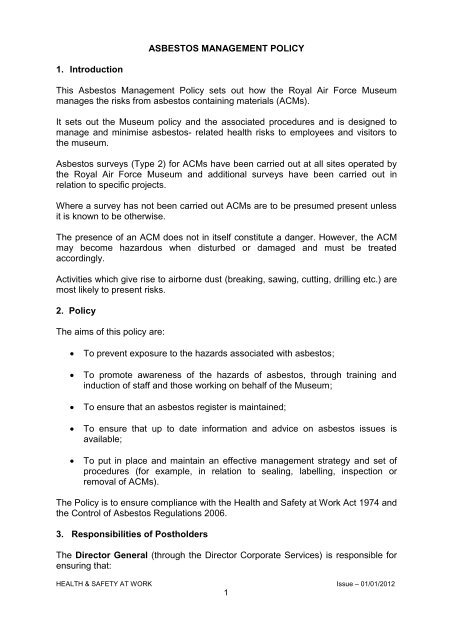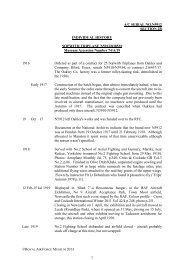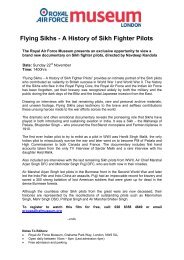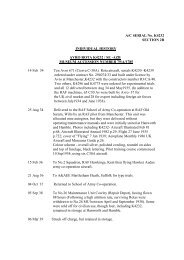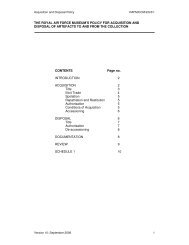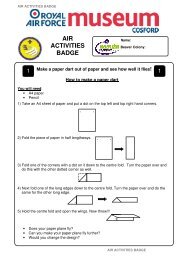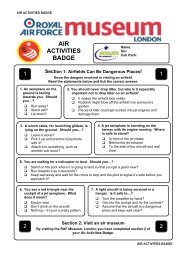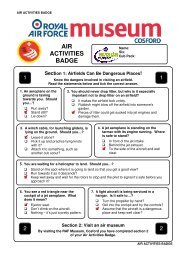Asbestos Policy v1 Jan 2012 - Royal Air Force Museum
Asbestos Policy v1 Jan 2012 - Royal Air Force Museum
Asbestos Policy v1 Jan 2012 - Royal Air Force Museum
- No tags were found...
Create successful ePaper yourself
Turn your PDF publications into a flip-book with our unique Google optimized e-Paper software.
ASBESTOS MANAGEMENT POLICY1. IntroductionThis <strong>Asbestos</strong> Management <strong>Policy</strong> sets out how the <strong>Royal</strong> <strong>Air</strong> <strong>Force</strong> <strong>Museum</strong>manages the risks from asbestos containing materials (ACMs).It sets out the <strong>Museum</strong> policy and the associated procedures and is designed tomanage and minimise asbestos- related health risks to employees and visitors tothe museum.<strong>Asbestos</strong> surveys (Type 2) for ACMs have been carried out at all sites operated bythe <strong>Royal</strong> <strong>Air</strong> <strong>Force</strong> <strong>Museum</strong> and additional surveys have been carried out inrelation to specific projects.Where a survey has not been carried out ACMs are to be presumed present unlessit is known to be otherwise.The presence of an ACM does not in itself constitute a danger. However, the ACMmay become hazardous when disturbed or damaged and must be treatedaccordingly.Activities which give rise to airborne dust (breaking, sawing, cutting, drilling etc.) aremost likely to present risks.2. <strong>Policy</strong>The aims of this policy are:To prevent exposure to the hazards associated with asbestos;To promote awareness of the hazards of asbestos, through training andinduction of staff and those working on behalf of the <strong>Museum</strong>;To ensure that an asbestos register is maintained;To ensure that up to date information and advice on asbestos issues isavailable;To put in place and maintain an effective management strategy and set ofprocedures (for example, in relation to sealing, labelling, inspection orremoval of ACMs).The <strong>Policy</strong> is to ensure compliance with the Health and Safety at Work Act 1974 andthe Control of <strong>Asbestos</strong> Regulations 2006.3. Responsibilities of PostholdersThe Director General (through the Director Corporate Services) is responsible forensuring that:HEALTH & SAFETY AT WORK Issue – 01/01/<strong>2012</strong>1
Adequate resources are provided and allocated to implement the <strong>Policy</strong>;<strong>Museum</strong> employees have the necessary facilities, training and competenceto discharge their designated functions;The <strong>Policy</strong> is underpinned by the appropriate procedures;Any specific responsibilities assigned to postholders are set out in writing.The Buildings & Services Manager is the designated <strong>Asbestos</strong> Manager (andProject Manager) on all matters relating to ACM’s in buildings, mechanical andelectrical fixed installations, and plant and equipment on all three sites. He will beassisted by designated staff on each site.The MBCC Manager is the designated <strong>Asbestos</strong> Manager (and Project Manager)on all matters relating to ACM’s in aircraft on display, in the MBCC workshops atCosford, and on aircraft restoration projects undertaken on any museum site.The following are designated as <strong>Asbestos</strong> Managers (and Project Managers) on allmatters relating to ACM’s contained within artefacts and aircraft on sites as stated:London Site: <strong>Air</strong>craft TechnicianReserve Collection Stafford: Manager StaffordCosford Including H9 Storage Hangar but excluding aircraft on display at Cosford:Cosford CuratorThe Health & Safety Managers at each site are responsible for:Undertaking audits as appropriate;Ensuring any breaches of compliance with the <strong>Policy</strong> or procedures are fullyinvestigated;Reporting incidents to the Health and Safety Executive under the Reportingof Injuries;Diseases and Dangerous Occurrences Regulations (RIDDOR);Collating Dangerous Occurrence Forms;The <strong>Asbestos</strong> Managers (as set out above) are responsible for ensuring that:Adequate information regarding ACMs is sought for all potential acquisitions;Any building or artefact acquired on behalf of the <strong>Museum</strong> is free of ACMs,so far as is reasonably practicable;HEALTH & SAFETY AT WORK Issue – 01/01/<strong>2012</strong>2
Employees acting on their behalf are aware of the <strong>Policy</strong> and procedures andhave the necessary training and competencies to undertake a given task; Any contractors employed on relevant work are similarly qualified; Information on ACMs is appropriately stored and is made available to anyinterested Parties (including Trade Unions);Proper records of asbestos works are kept;An <strong>Asbestos</strong> Register is maintained and audited regularly;Risk assessments, management options and emergency procedures arecompleted, developed and established as necessary;A list of Licensed <strong>Asbestos</strong> Removal Contractors and Analytical Companiesapproved for use on <strong>Royal</strong> <strong>Air</strong> <strong>Force</strong> <strong>Museum</strong> sites is maintained.Project Managers (those co-ordinating relevant works) are responsible for ensuringthat:The necessary requirements for the safe management of ACMs are fullyidentified and incorporated into any design or specification for refurbishmentof artefacts or exhibits, locations subject of assessment being addressed atan early stage;All appropriate actions are completed;The relevant <strong>Asbestos</strong> Manager is informed of progress and any outcomes;All staff working on a project are informed of the location of any knownACMs;Works are halted if suspect ACMs are discovered during the course of workand further advice is sought from the <strong>Asbestos</strong> Manager before proceeding.Contractors are responsible for:Complying with current legislation, associated Approved Codes of Practiceand Guidance and the <strong>Royal</strong> <strong>Air</strong> <strong>Force</strong> <strong>Museum</strong> <strong>Policy</strong> and procedures;The preparation of quotations for asbestos remedial works which takeaccount of and specify any health and safety issues;Providing a Plan of Work to the Project Manager which includes details ofresources, a timetable and an emergency procedure - all agreed with theProject Manager;HEALTH & SAFETY AT WORK Issue – 01/01/<strong>2012</strong>3
Providing Statutory Notice to the Statutory Authority prior to commencingasbestos works, or, by agreement with the Project Manager, applying for awaiver from the minimum notice period;Attending the contract pre-start meeting, progress meetings and handovermeetings as required;Carrying out regular inspections of the work environment, any defects foundbeing reported to the Project Manager or being rectified by the Contractorimmediately;Complying with all reasonable requests from the Project Manager;Complying with Permits to Work;Liaising with the Analyst (see below) to ensure the satisfactory progress ofthe works;Providing copies of notification and consignment notes and other relevantdocumentation with the final account to the Project Manager.Consultants and UKAS Accredited Analysts<strong>Museum</strong> staff will be supported by a Nominated <strong>Asbestos</strong> Consultant who, onrequest, will provide:Pro-active support to the <strong>Asbestos</strong> Manager, but to a level which would notfall within the HSE requirement for a Supervisory License;A review and comment on asbestos works specifications and, prior to start ofthe works, on a contractors Plan of Work;Quotations concerning the project site and analytical requirements;Attendance at meetings, including but not restricted to, pre-start, progressand handover meetings;Completion of check lists, warning and advisory signs etc. as supplied by theProject ManagerAssistance with the application and completion of <strong>Museum</strong> specified permitsand warning signs relevant to any remedial project, including hot workspermits, etc.;Analytical works and inspections as agreed with the Project Manager;Reports to the Project Manager regarding any defects or non-compliancesrelating to the contractors performance. (Where the Project Manager is notimmediately available the Consultant/Analyst is to take any measuresHEALTH & SAFETY AT WORK Issue – 01/01/<strong>2012</strong>4
necessary to ensure the health and safety of the contractor and buildingoccupants);Completion checks to ensure that the contractor has completed workssatisfactorily;Daily written reports on project progress to the <strong>Asbestos</strong> Manager;Formal reports, including 4 Stage Clearance and Certificate of Re-Occupation, to the <strong>Asbestos</strong> Manager on completion of site works.Heads of Department are responsible for ensuring that:All staff are aware of their individual responsibilities under this <strong>Policy</strong>;Departments implement any measures deemed necessary by the <strong>Asbestos</strong>Manager;Equipment, materials and apparatus containing ACMs are clearly identified,appropriately recorded and managed;Attendance of staff for asbestos awareness training as required.Staff (and Volunteers) are responsible for:Reporting to the <strong>Asbestos</strong> Manager, any known ACMs which are damaged ordisturbed or any suspect ACMs of any condition and any defects or concernsthey may have related to asbestos issues or remedial works;Contacting their <strong>Asbestos</strong> Manager or Project Manager (where appointed)regarding any work to be undertaken which may involve ACMs;Attending asbestos awareness training as required.4. Acquisition of ExhibitsThe <strong>Museum</strong> will not normally increase its holdings of material containing asbestosby knowingly acquiring any objects containing any form of asbestos material. Allobjects intended for acquisition will be checked initially by thorough research, inquiryand physical inspection. Where an item is being considered for acquisition thejustification will be set out by a Curator, in consultation with an <strong>Asbestos</strong> Manager.If any object is considered to present too great a risk to staff or visitors it will not berecommended for acquisition. The final decision will be made by the DirectorGeneral in consultation with the Curators where agreement cannot be reached.5. Risk Assessments of ACM’sAll ACMs in the <strong>Asbestos</strong> Register are objectively assessed by the appropriate<strong>Asbestos</strong> Manager using a formal scoring scheme. This considers aspects ofHEALTH & SAFETY AT WORK Issue – 01/01/<strong>2012</strong>5
materials assessment and priority assessment as described in the HSE documentHSG 227 ‘A comprehensive guide to managing asbestos in premises’.The materials assessment considers features of the material and the priorityassessment takes into account the environment in which the ACM is located and thelikelihood that persons may be exposed to asbestos fibres.The scheme considers the following:product type;condition;surface treatment;asbestos type;location;position of material( for example, how accessible it is during normal buildingoccupancy);susceptibility to damage;number of people potentially exposed;whether the material is subject to maintenance, refurbishment or otherpossible disturbance.The <strong>Asbestos</strong> Manager manages and keeps details on the scoring scheme andreviews the scores annually. ACMs with higher assessment scores are likely torequire greater consideration regarding remediation measures than those with lowerscores.6. Management of ACMsManagement options contained in the <strong>Asbestos</strong> Register are assigned by the<strong>Asbestos</strong> Manager and are considered the appropriate choice at the time ofRegister review.The option chosen will be determined by the <strong>Asbestos</strong> Manager after considerationof the assessment score and discussion with relevant parties, for example, thosewith information on future maintenance or refurbishment plans.Long term ACM maintenance considerations (including cost, resources, potential forexposure), will also be considered and opportunities taken for removing materials,particularly during periods of building closure or refurbishment. In general, ACMswith higher risk scores will be identified for remedial works, whilst those with lowerscores will be retained within the management scheme for in-situ materials.HEALTH & SAFETY AT WORK Issue – 01/01/<strong>2012</strong>6
7. Inspection and Labelling of ACMsFormal re-inspections of known or suspected ACMs (based upon the <strong>Asbestos</strong>Register) will be carried out by the <strong>Asbestos</strong> Consultant and will be arranged andco-ordinated by the appropriate <strong>Asbestos</strong> Manager. Re-inspection findings will beused to update the <strong>Asbestos</strong> Register and subject to formal risk assessment. Theperiod between inspections will be set by the <strong>Asbestos</strong> Managers, taking intoconsideration a review of current risk assessments and previous inspection history.ACMs with higher score may be subject to more regular re-inspection than thosewith lower scores.Where ACMs are in good condition, with minimal potential for fibre release, theymay be left in-situ. The designated <strong>Asbestos</strong> Manager is responsible for ensuringthese materials are kept in a sound condition, but ACMs left in-situ will be subject toan inspection regime. The <strong>Asbestos</strong> Manager will determine the inspection period,likely to be 6 or 12 months dependent on the risk assessment.Labelling with standard ‘asbestos warning labels’ or fixing of appropriate warningsignage will be carried out for all known accessible ACMs considered to be ofsignificant risk where this will prevent accidental damage and not cause undueconcern.Labelling of lower risk materials, for example, floor tiles, gaskets, may not be carriedout if other control mechanisms (e.g. site awareness) are considered adequate inpreventing accidental exposure.8. Improvement Works and Removal of <strong>Asbestos</strong> MaterialsWhere an ACM sustains minor damage, simple repair and/or sealing(encapsulation), may be appropriate. The technique and materials used will bedependent on the ACM and may include over-cladding or use of liquid appliedencapsulates. These encapsulates are typically polymeric applications which dry togive a robust water resistant surface. Work on materials requiring an asbestoslicense will only be completed by a licensed asbestos contractor.The term ‘removal’ is used to describe both the removal of bulk materials and thedecontamination of areas where debris or trace asbestos contamination has beenidentified.Removal of ACMs is carried out as a result of:Such work being required by an <strong>Asbestos</strong> Manager;Recommended works related to planned projects;Unplanned circumstances (for example, identification of high risk ACMs,damage to ACMs, arising from maintenance or building works andunforeseen).The option to remove ACMs will be authorised by:HEALTH & SAFETY AT WORK Issue – 01/01/<strong>2012</strong>7
An <strong>Asbestos</strong> Manager for aspects of on-going management of ACMs;A Project Manager for any specific building or project works.The responsibility for arranging and co-ordinating asbestos remedial works lies withProject Managers. Removal of ACMs is an operation with inherent risks andrequires careful management by qualified persons.Consideration of building occupation, co-ordination with other projects and theeffective use of budgets, will be taken into account when arranging remedial works.Remedial works planning must allow sufficient time for key stages, including:Agreement of scope of works;Contractor’s quotation period;Method statement assessment;Decant arrangements;Statutory HSE notification;Re-instatement requirements assessment;Occupant Liaison meetings;Pre-start meeting.9. Completion of <strong>Asbestos</strong> WorksThe <strong>Asbestos</strong> Manager will generally provide a completion report which will include:a summary of what materials have been removed;project references;contact and documentation details;comment on residual asbestos risks.Records will be held by <strong>Asbestos</strong> Managers (with relevant documents copied toProject Managers). These will include:Works specification;Removal method statement;HEALTH & SAFETY AT WORK Issue – 01/01/<strong>2012</strong>8
<strong>Air</strong> monitoring reports;Certificate of Re-Occupation with Clearance (Stage 4) documentation (whererelevant);Waste consignment notes.10. Emergency Reporting Of Suspected <strong>Asbestos</strong> Containing Material (ACM)The following procedure should be followed by all <strong>Museum</strong> staff, contractors,volunteers etc., whenever suspected ACMs are discovered during work or knownACM’s become damaged by any other physical method.Stop work immediately;Isolate the area (i.e. shut doors and windows, turnoff ventilation systemsand fans);Post warning notices (if available) and inform people in the immediatearea and request that everyone keep away;Contact immediately the nominated <strong>Asbestos</strong> Consultant (if appropriate)and the site General Manager and provide them with details of theincident;Check the on-site register to establish whether ACMs are known to bepresent in the area. In circumstances where no register details areavailable the <strong>Museum</strong> will arrange sampling testing and analysis by aUKAS accredited laboratory;If the analysis proves that the material does not contain asbestos thenwork can continue and normal repairs carried out. If the analysis provesthe material to be an ACM then either remedial works or removal will becarried out, if necessary, by a licensed asbestos removal company, all inaccordance with the Control of <strong>Asbestos</strong> Regulations 2006.Do not attempt to take a sample. Should the material be found to containasbestos and the work required means that a licensed contractor isnecessary, then:An asbestos removal contractor and analyst will be appointed;The work must be agreed with the analyst and asbestos removalcontractor to remove the material as soon as possible;The removal contractor will submit notification to the HSE where it isrequired;HEALTH & SAFETY AT WORK Issue – 01/01/<strong>2012</strong>9
The area will remain closed until the asbestos works have beencompleted and the analyst has issued the relevant certificate ofreoccupation.11. Persons becoming contaminated with asbestos fibresIf any person believes he/she may have become exposed to and their clothingcontaminated by asbestos fibres following a release of asbestos the followingprocedure should be adopted:The above procedure should be followed securing the safety of others in thebuilding.The contaminated person should go directly to the outside of the building and findan isolated area. (Not if large numbers of people prevent easy or direct egress).If access to the outside is not available use an adjoining vacant room.Suitable overalls and disposal bags should be given to the contaminated person.The contaminated person should change into the overalls and place all externalclothing being worn at the time of exposure, into the disposal bags. The bags shouldthen be double bagged and conspicuously marked asbestos.If it is found that the contamination was asbestos then the clothes will be disposedoff as if ACM.The relevant areas will be closed and sealed.HEALTH & SAFETY AT WORK Issue – 01/01/<strong>2012</strong>10


